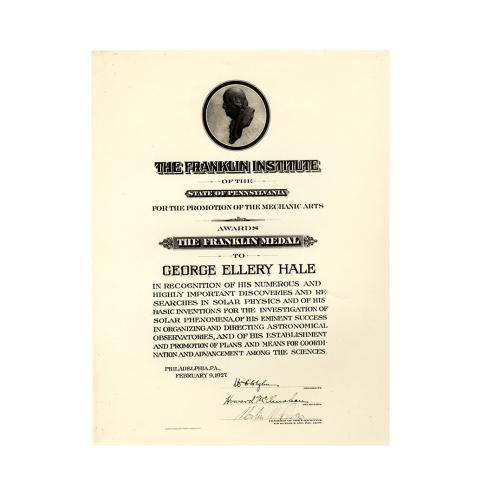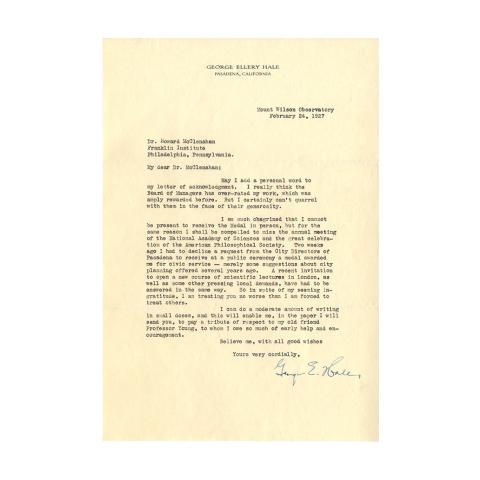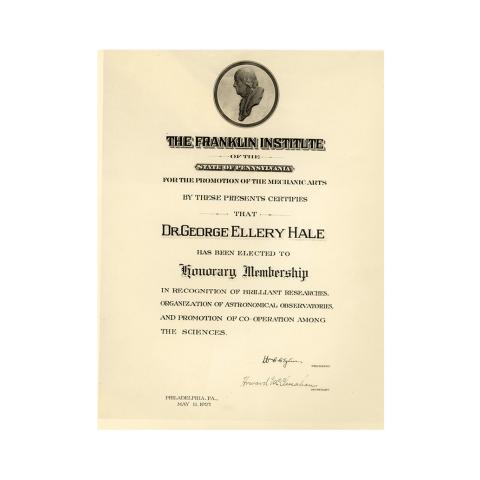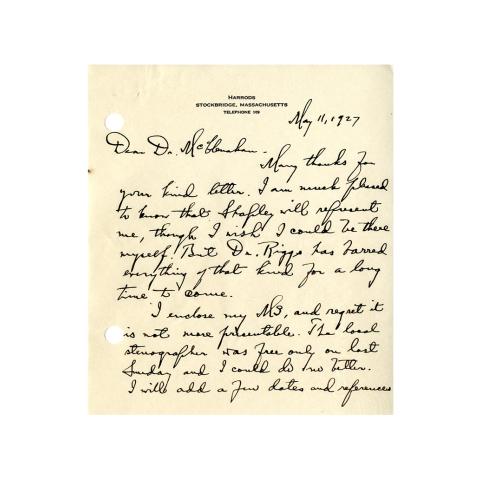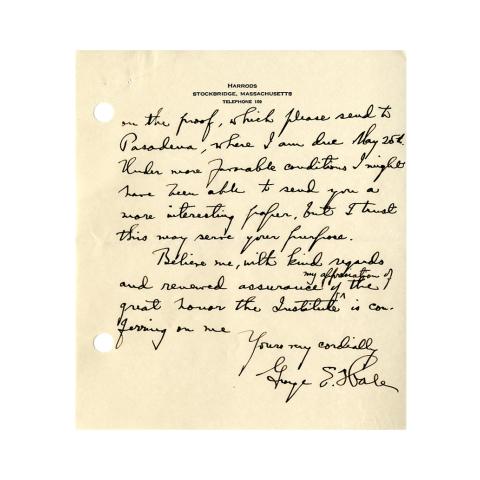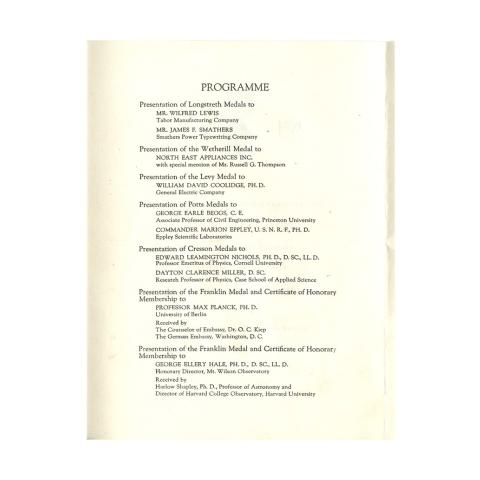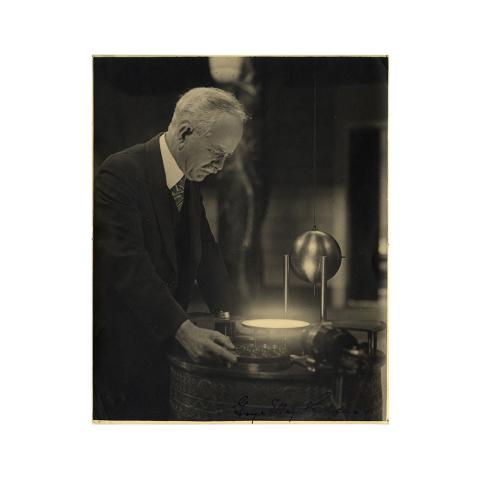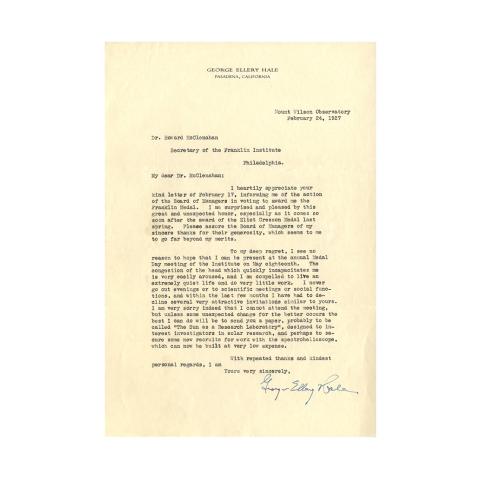
Introduction
From an early age, George Ellery Hale was interested in astronomy; his life's work included solar research and the construction of world famous observatories. Hale believed in the importance of sharing scientific discovery, and his work laid the cornerstone for the exploration of the Sun.
Who was George Ellery Hale and what did he contribute to the science of astrophysics? What is a spectroheliograph and why did Hale build one?
Over All Else
George Ellery Hale was born in Chicago on June 29, 1868, the eldest of three children, into a family of wealthy circumstances. His father, William Ellery Hale, was an inventor and manufacturer of elevators for the multi-story buildings being built in Chicago and elsewhere. Hale attended public school and then, at age fourteen, entered the Chicago Manual Training School which added instruction in mechanical ability to standard scholarly subjects. Hale's interest in astronomy developed and, encouraged by his parents, he acquired a telescope and designed a home workshop/observatory which included a 4-inch Clark refractor on the roof. Here, at the age of fifteen, he photographed the May 1883, solar eclipse. Later in life, Hale said of astronomy that "he would rather do such work than anything else in the world."
Thus, Hale began a life in science in which he combined grand ideas that became world famous observatories and conducted individual research on solar activity that increased fundamental knowledge of the universe—many of these achievements reached before his thirty-sixth birthday.
Pursuing Astrophysics
Although taught by classical astronomers, Hale pursued astrophysics. Investigating the nature of the stars rather than their position and dimensions and using spectroscopy to isolate areas of the sun he chose to study. Unimpressed by standard schooling, Hale left Chicago to attend the Massachusetts Institute of Technology in 1886 and majored in physics. At MIT, his most enjoyable experiences were the times spent volunteering with Professor Pickering at the Harvard College Observatory. Hale spent his summer breaks at home in his backyard "Kenwood Observatory" built by his father, which contained a workshop, dark room, and a heliostat, the mirror used to reflect sunlight to a grating spectrograph. Now, Hale was able to investigate solar phenomena at his leisure. During a meeting with Charles Young at Princeton, he came up with an idea after he saw a solar prominence, the big bright formation which spouts from sunspots at the Sun's surface, for the first time. Independent of others, Hale built a spectroheliograph that would isolate and examine specific amounts of the Sun's rays yielding new detailed information, which he submitted for his senior thesis at MIT.
Greater Worth
Two days after graduating from MIT, George Hale married Evlina S. Conklin. They honeymooned in California where he visited the Lick Observatory and then returned home to his Kenwood Central Laboratory to devote himself to solar research and some teaching at Beliot College where his father had endowed a chair in science instruction. He hired an assistant, the photographer Ferdinand Ellerman, who became a lifelong collaborator. Then, he set out to visit astronomers and observatories throughout Europe to promote his conviction that greater worth came from astronomical data and observations shared among the world fraternity of scientists rather than from isolated research with astronomers pursuing their individual interests.
Yerkes
In 1892, Hale was appointed Associate Professor of Astrophysics at the University of Chicago, as well as Director of the Kenwood Observatory that his father then donated to the university. Hale happened upon the availability of the newest 40-inch telescope discs and began a five-year acquisition campaign, which resulted in the Yerkes Observatory, located in Williams Bay, Wisconsin, far from ambient light interference, and financed by Charles Yerkes, an industrialist of questionable reputation but available riches. When the Yerkes Observatory opened—conceived by Hale, designed by Hale, and staffed by Hale—George Hale was 29 years old.
In addition to fundraising, Hale was busy during those five years. He studied in Germany but left his doctorate program incomplete, founded the Astrophysical Journal to promote scientific cooperation, and became an entrepreneur of astronomy. He also played an important part in the 1899 establishment of the American Astronomical Society.
Exciting and Productive
The Yerkes Observatory 40-inch telescope represented the limit of refractor applications and Hale directed his considerable energy to the next step—a 60-inch reflector telescope. This time, Hale's much larger campaign was financed by the Carnegie Institution of Washington and the Hale family moved to an ideal observation area in Pasadena, close to Wilson's Peak. The independent observatory opened at Mount Wilson in 1904 with the largest telescope in the world. Hale then resigned from the University of Chicago and his solar research was undertaken by scientists who moved over from the Yerkes Observatory. In the same year, the International Union for Cooperation in Solar Research was created.
The work begun at Mount Wilson was exciting and productive. Matching astronomy and physics to build instruments, gather data, and test conclusions in the laboratory made research advance quickly. During this time, Hale was able to experimentally verify his greatest discovery: spectral displacement in sunspots is caused by the Sun's magnetic field.
The civic-minded George Hale also devoted time to the progress in the city of Pasadena, serving on boards and commissions as the city rapidly expanded. As a 1907 trustee of the multi-purpose Throop Polytechnic Institute, he led its reorganization into a post-secondary science and engineering school which became the world-renowned California Institute of Technology with an emphasis on fundamental research.
Importance of Sharing
Expansion at Mount Wilson continued, and the pace, pressures, and his extreme energetic enthusiasm may have contributed to the first nervous breakdown in 1910 that compelled Hale to take a year away from work. During that break, he traveled with his wife to Europe and Egypt, keeping his scientific contacts to a minimum.
As World War I began in 1914 in Europe, Hale pursued his belief in the importance of sharing scientific discovery and, from his position with the National Academy of Sciences, promoted the goal of a group to advise the government on scientific policy. He founded and chaired the National Research Council and ran the scientific war effort for three years.
The World's Largest
In the following years, Hale's health became unpredictable; he stepped down from leadership of Mount Wilson and worked in a private observatory he built at home while writing about astrophysics for experts and for the general public. His final accomplishment typified his life goals. He brought the rival Carnegie (Mount Wilson) and Rockefeller (Caltech) foundations together to finance the 200-inch telescope built at the Mount Palomar site he helped select. It was Hale's third experience in establishing "the world's largest telescope."
George Ellery Hale died in Pasadena on February 21, 1928. The Palomar Observatory was dedicated ten years after his death containing the aptly named Hale Telescope.
Fingerprint
When a mixture is heated up until it glows brightly and that excited "glow" is passed through a narrow slit and then through a prism, only certain bright color lines in the resulting spectrum are observed. The spectral lines emitted are uniquely characteristic of the elements in the mixture and each element has a unique, unchanging line pattern, an analytical "fingerprint."
When sunlight is examined in the same way, the fingerprint isolates the characteristics of elements in the Sun's atmosphere. Gases in the Sun's atmosphere are slightly cooler than its surface and the chemical elements in the gases absorb certain frequencies of the light energy. The result is a spectrum with a number of dark lines corresponding to the energy absorbed by those elements, an absorption spectrum fingerprint.
Spectroheliograph
The cornerstone for exploration of the Sun, the science of astrophysics, was laid by George Hale in 1890 when, for his senior thesis at the Massachusetts Institute of Technology, he built the first successful spectroheliograph.
The spectroheliograph makes a photographic image of the Sun's visible surface in light of a single, selected spectral line. A telescope's image of the Sun is focused onto the entrance slit of a spectrograph where a collimator forms the light into a parallel beam and directs the beam at a diffraction grating that separates the beam into a spectrum; a second slit isolates a selected wavelength from this spectrum. Coordinating the movement of both slits produces, on the photographic plate detector, a monochromatic image of the Sun's surface.
Hale's later invention of the spectrohelioscope replaced the photographic detector of the spectroheliograph with the human eye. Now, direct visual examination of the Sun's surface is made possible by vibrating the slits in unison in a small amplification range. The viewer sees an image that appears steady because of the persistence of vision—the perception that rapidly changing images are constantly steady.
Collecting Beams
Hale's spectroheliograph set-up occupied an area over 30 feet long consisting of an exterior light collection apparatus and a small building. The collected beam was directed into the building through a hole in the wall and inside the building were the mirror, the apparatus holding the two slits, the diffraction grating, the photographic plate arrangement, and connectors to control the exterior apparatus.
The sunlight was collected by a heliostat, a clockwork-driven apparatus that keeps a mirror tracking the Sun by compensating for the Earth's rotation and reflecting the Sun's rays to a fixed spot. The light rays passed through a lens, into the building, and through the first slit. Light of the selected wavelength then traveled 13 feet to reflect off a concave mirror onto a diffraction grating which further refined the wavelength to reflect off another mirror and back to the viewer or photographic plate.
The new instrument was put to work each sunny day, recording the Sun's surface activity to yield photographic evidence of violent magnetic storms and changes in erupting solar prominences and faculae around the edge of the solar disk.
Laboratory experiments comparing the spectral lines of known hot gas mixtures with those of sunlight components showed that certain chemical elements, especially hydrogen, were common to the Earth and the Sun.
Landmarks
The spectroheliograph in use at the Yerkes Observatory brought proof of the distribution of elements, such as calcium, at various densities in layers of the Sun's atmosphere. Hale named the billowing clouds of calcium and hydrogen vapor "flocculi."
Hale made his greatest discovery while working at the Mt. Wilson Observatory. In laboratory experiments, he matched the spectral lines emitted by sunspots, the dark areas of the Sun where the temperature drops hundreds of degrees below that of the surrounding photosphere. By applying the Zeeman effect of magnetic displacement to the spectral data, Hale proved the existence of the shifting magnetic field present in sunspots. Further observation and experimentation led Hale and his group to discover the Sun's entire magnetic field and its polarity reversals with the sunspot cycle.
Hale's instrumentation plus the observatories he designed and built are landmarks in the history of astrophysics and cosmology.
Acknowledgement
Throughout the world and throughout his life, beginning at the age of 26, George Ellery Hale was honored for his contributions to the development of astrophysics. Among the honors were:
- The 1894 Janssen Medal from the Paris Academy of Sciences
- The 1902 Benjamin Count Rumford Medal from the American Academy of Arts & Sciences
- The 1904 Draper Medal from the National Academy of Sciences
- The 1904 Gold Medal of the Royal Astronomical Society
- The 1916 Catherine Wolfe Bruce Gold Medal from the Astronomical Society of the Pacific
- In 1919 he was elected an associate of Academie des Sciences, Institut de France
- The 1920 Galileo Medal from the University of Florence
- The 1921 Actonian Prize from the Royal Institution of London
- The 1926 Elliott Cresson Medal from The Franklin Institute of Philadelphia
- The 1926 Arthur Noble Medal from the City of Pasadena
- The 1927 Franklin Gold Medal from The Franklin Institute of Philadelphia
- The 1932 Sir Godfrey Copley Medal from the Royal Society of Great Britain
- The 1935 Frederic Ives Medal from the Optical Society of America
Belgium awarded Dr. Hale the Medal of Merit of the Order of Leopold, Italy awarded him the Order of the Crown of Italy, and he was an honorary member of the Vienna Academy of Sciences.
Credits
The George Ellery Hale presentation was made possible by support from The Barra Foundation and Unisys.
Read the Committee on Science and the Arts Report on George Ellery Hale’s early life and his work in solar physics.


